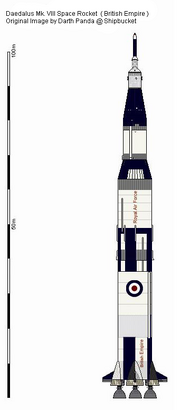
The profile of a British Daedalus Mk.VII rocket.
The Daedalus Programme was the initial Moon Landing Programme undertaken by RAF Space Command and several supporting Allied Space Agencies during the 1970s, most famously the first manned moon landing in history on 20th June 1971.
First efforts[]
Initially the Space Programme suffered from technical problems as well as a lack of official interest, but as the British Economy continued to grow throughout the 1950s RAF Space Command was founded in 1956 to spearhead British and by extension Allied efforts in space. Funding issues evaporated overnight when the American People's Aeronautics and Space Agency launched Traveller One, the world's first artificial Satellite in 1957, thus starting the space race.
In September 1961 Squadron Leader Edward Thorngrave became the first man in space, followed closely by the American Captain Jackson in April 1962.
By that time a concept for a moon landing existed in Whitehall and Freetown, but Space Command faced severe technical challenges that would take years to overcome.
Daedalus rising[]
By autumn 1962 intelligence reached the British Government via a highly placed (and to this day unnamed and secret) source that the American People's Army Air Force was kick-starting a lunar flight programme of their own, and suddenly Space Command was 'strongly encouraged' to have one of their own. Within days Sergey Korolev and Bernard Quartermass were briefing London, even though the ten year shedule the men had set met with severe disapproval at the time.
But as Korolev pointed out, the then-current Labour Government was unwilling to fund the Space Command unless they had a long-term and 'beyond the Moon' plan for use of the expensive technology. Therefore the two men offered a whole range and family of rockets, all using technology and parts of what they called the Daedalus programme, allowing all but the first stage of a prospective Moon rocket being built in much greater numbers and thus more cheaply than the current line of rockets used for lifting Satellites and space capsules.
This was approved and preparations began.
Daedalus struggling[]
When the Programme started in earnest in 1964, the civillian Scientific Group of Space Command had set themselves a massive challenge, not helped by emerging technical problems.
The Daedalus Rocket Line which is so successful to this day (though regularly upgraded with new technology) that the early failures are often forgotten.
In 1965 the first manned Daedalus I launch experienced severe Pogo problems and exploded in flight, taking three British Astronauts with them, warranting a complete re-design of the Engines and nearly led to Korolev's resignation from Space Command.
Another issue was that in spite of promises the costs exploded as the new series of N-series engines took two years of expensive tests to make reliable, forcing Space Command to rely on older-model rockets for ongoing missions.
But by 1967 the N-4, five of which were to be used as the first-stage engines for the projected Daedalus 6 Moon rocket were declared reliable and successfully tested by then-Squadron Leader John Dashwood on a series of orbital flights.
Preparations continued apace, in the Empire and America, but by 1970 it became clear that the British were more successful at solving the various technological challenges and on June 16th 1971 Mission Daedalus VIII launched from the Space Centre at Freetown.
Successors[]
Even though variants of the Daedalus line serve to this day, Space Command is currently developing successor systems to both it and the Icarus Spaceplane, both have are currently (as of 2014) undergoing prototype testing and are expected to enter operational service by 2020.